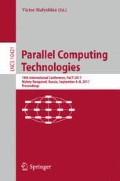Abstract
The synchronization in cellular automata has been known as the firing squad synchronization problem (FSSP) since its development, where the FSSP gives a finite-state protocol for synchronizing a large scale of cellular automata. A quest for smaller state FSSP solutions has been an interesting problem for a long time. Umeo, Kamikawa and Yunès [9] answered partially by introducing a concept of partial FSSP solutions and proposing a full list of the smallest four-state symmetric powers-of-2 FSSP protocols that can synchronize any one-dimensional (1D) ring cellular automata of length \(n=2^{k}\) for any positive integer \(k \ge 1\). Afterwards, Ng [7] also added a list of asymmetric FSSP partial solutions, thus completing the four-state powers-of-2 FSSP partial solutions. The number four is the smallest one in the class of FSSP protocols proposed so far. A question remained is that “are there any other four-state partial solutions?”. In this paper, we answer to the question by proposing a new class of the smallest four-state FSSP protocols that can synchronize any 1D ring of length \(n=2^{k}-1\) for any positive integer \(k \ge 2\). We show that the class includes a rich variety of FSSP protocols that consists of 39 symmetric solutions and 132 asymmetric ones, ranging from minimum-time to linear-time in synchronization steps. In addition, we make an investigation into several interesting properties of these partial solutions such as swapping general states, a duality between them, inclusion of powers-of-2 solutions, reflected solutions and so on.
Access this chapter
Tax calculation will be finalised at checkout
Purchases are for personal use only
References
Balzer, R.: An 8-state minimal time solution to the firing squad synchronization problem. Inf. Control 10, 22–42 (1967)
Berthiaume, A., Bittner, T., Perković, L., Settle, A., Simon, J.: Bounding the firing synchronization problem on a ring. Theor. Comput. Sci. 320, 213–228 (2004)
Gerken, H.D.: Über Synchronisationsprobleme bei Zellularautomaten, pp. 1–50. Diplomarbeit, Institut für Theoretische Informatik, Technische Universität Braunschweig (1987)
Goto, E.: A Minimal Time Solution of the Firing Squad Problem. Dittoed course notes for Applied Mathematics 298 (with an illustration in color). Harvard University, Cambridge (1962)
Mazoyer, J.: A six-state minimal time solution to the firing squad synchronization problem. Theor. Comput. Sci. 50, 183–238 (1987)
Moore, E.F.: The firing squad synchronization problem. In: Moore, E.F. (ed.) Sequential Machines, Selected Papers, pp. 213–214. Addison-Wesley, Reading MA (1964)
Ng, W.L.: Partial Solutions for the Firing Squad Synchronization Problem on Rings, pp. 1–363. ProQuest publications, Ann Arbor (2011)
Sanders, P.: Massively parallel search for transition-tables of polyautomata. In: Jesshope, C., Jossifov, V., Wilhelmi, W. (eds.). Proceeding of the VI International Workshop on Parallel Processing by Cellular Automata and Arrays, Akademie, pp. 99–108 (1994)
Umeo, H., Kamikawa, N., Yunès, J.-B.: A family of smallest symmetrical four-state firing squad synchronization protocols for ring arrays. Parallel Process. Lett. 19(2), 299–313 (2009)
Umeo, H., Yanagihara, T.: A smallest five-state solution to the firing squad synchronization problem. In: Durand-Lose, J., Margenstern, M. (eds.) MCU 2007. LNCS, vol. 4664, pp. 291–302. Springer, Heidelberg (2007). doi:10.1007/978-3-540-74593-8_25
Waksman, A.: An optimum solution to the firing squad synchronization problem. Inf. Control 9, 66–78 (1966)
Yunès, J.B.: A 4-states algebraic solution to linear cellular automata synchronization. Inf. Process. Lett. 19(2), 71–75 (2008)
Author information
Authors and Affiliations
Corresponding author
Editor information
Editors and Affiliations
Rights and permissions
Copyright information
© 2017 Springer International Publishing AG
About this paper
Cite this paper
Umeo, H., Kamikawa, N. (2017). A New Class of the Smallest Four-State Partial FSSP Solutions for One-Dimensional Ring Cellular Automata. In: Malyshkin, V. (eds) Parallel Computing Technologies. PaCT 2017. Lecture Notes in Computer Science(), vol 10421. Springer, Cham. https://doi.org/10.1007/978-3-319-62932-2_22
Download citation
DOI: https://doi.org/10.1007/978-3-319-62932-2_22
Published:
Publisher Name: Springer, Cham
Print ISBN: 978-3-319-62931-5
Online ISBN: 978-3-319-62932-2
eBook Packages: Computer ScienceComputer Science (R0)

